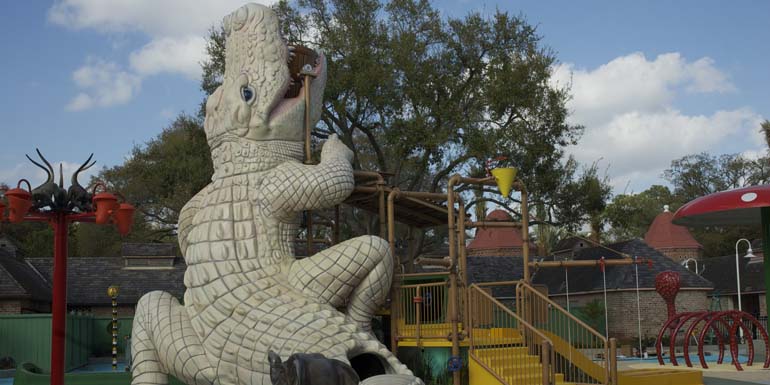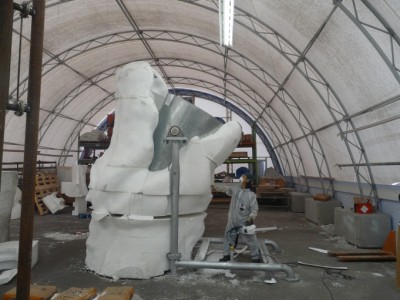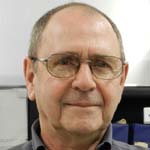Creating a rare water play structure
by Sally Bouorm | December 1, 2011 2:31 pm
 [1]
[1]By Colin Atkinson
WhiteWater West Industries, a waterpark and aquatic attraction design/build firm in Richmond, B.C., installed its first North American zoo water play structure as part of the new splash park attraction at the Audubon Zoo in New Orleans, La., which opened earlier this year.
This was not a typical installation, however, as WhiteWater was asked to bring the water park attraction, appropriately named ‘Cool Zoo,’ to life, as park officials were looking to add a refreshing new element to the popular zoo. In doing so, WhiteWater designed a custom multi-level interactive play structure with a life-like alligator as its central theme. This was no ordinary alligator, however; as it had to be an accurate reproduction of ‘Spot,’ the Audubon Zoo’s resident albino alligator, which meant incorporating his rare albino colouring.
As WhiteWater’s water play centres are modularly constructed, they can be built anywhere. For instance, the water play structure used for this project contains 15 standpipes, which are joined together by horizontal pipes, some of which carry water to feed the various features, including the tipping bucket and fibreglass reinforced plastic (FRP) horizontal platforms and stairs. Modular assembly was extremely beneficial for this project, as it allowed various stages of design, fabrication and construction to be carried out in Richmond and Kelowna, B.C., as well as in New Orleans.
Unique challenges
 [2]
[2]Although the company produces several aquatic play structures in any given year, this project presented installers with some unique challenges. Creating support for the 4,990-kg (11,000-lbs), 8.5-m (28-ft) alligator, which would hold the tipping bucket in its opening-and-closing mouth, was the first challenge, while determining the schematics of the alligator’s integral waterslide, which would see bathers exiting through its tail, was another.
Due to these unique challenges and the customization involved, one condition of the contract required WhiteWater’s in-house design team to create a scale model of the proposed alligator theme for presentation and approval by Audubon Zoo officials. Once approved, the clay model was then scanned using a 3-D scanner, which would allow WhiteWater to start fabricating the alligator structure.
After collecting the electronic data, which comprised information on the model’s shape and appearance, it was then uploaded to a five-axis, computer-controlled cutting machine. Rough shapes were cut from Styrofoam blocks, which were glued together to form the alligator’s rough outline. Final shaping and sculpting was then performed by the company’s skilled theming technicians.
At this point, however, due to the sheer size of the structure, it was quickly realized there would not be enough headroom nor floor space to pre-assemble the full-sized alligator in WhiteWater’s Richmond facility. As a result, pre-assembly was moved to the company’s manufacturing site in Kelowna. This was beneficial in two ways, as the cutting machine was located there and the assembly area was isolated from the plant, so it did not interfere with regular manufacturing operations. However, even the ceiling in this building did not provide enough clearance to allow the alligator’s head to be pre-assembled to the body. The head was not mounted onto the alligator’s body until it was erected in New Orleans.
At this point, all the components for the waterpark, (e.g. water play centre, one of the fibreglass slides and fibreglass decks and stairs), were shipped to the site to start construction before the arrival of the alligator.
Sculpting an alligator
 [3]
[3]In order to finish constructing the alligator in Kelowna, a mock-up section of the water play centre was fabricated using part of another fibreglass slide so the slide could be incorporated into the alligator’s tail.
The unit was then assembled as complete as possible, minus the head, to start the sculpting process. This was a painstaking task, as the reality and proportion of the alligator relied heavily on the skill of the sculptors. Although it sounds relatively simple, in this case, sculpting the alligator was quite difficult, as only a small percentage of the structure was visible at a time. This meant sculptors had to frequently step back from the project to assess progress and perspective.
To incorporate the tipping bucket into the mouth of the alligator, its head had to be formed around the bucket. In order to allow the tipping bucket to fall, the alligator’s jaw was fixed to the bucket. This would allow the lower jaw to open as the bucket tips and discharges 1,200 L (317 gal.) of water onto a lower splash roof.
After consensus was reached that the alligator was realistic and proportional, construction joints were placed at strategic positions in the structure to allow disassembly into shippable sub-assemblies.
The next step was hard coating the entire structure (i.e. body and head). This is a form of waterproofing, which prevents water from penetrating into the Styrofoam and rendering it unusable. Once this was completed, the alligator was painted. First, a base coat was applied to provide the background colour (creamy grey) of the albino alligator, and then intricate details were added to produce the alligator’s scaly appearance. Final painting and hard coating of the construction joints was performed on-site after the structure was assembled.
Shipping and assembly
The completed alligator was shipped in sections on flatbed trucks. Unfortunately, however, the body section was too big to be transported in this manner. As a result, it had to be shipped on a specialized ‘over-width’ transport truck, which had to travel with pilot cars through Louisiana.
 [4]
[4]Once all the components arrived to the Audubon Zoo, construction of the alligator was performed by Francise Articultural Services of New Orleans under the direction of WhiteWater’s supervisors who also assisted with assembly. This involved filling any voids between the parts with expanding foam, overlaying the joints with fibreglass matting, gel coating and painting to match the rest of the alligator.
When construction was complete, the alligator-themed water play centre measured 8.5-m (28-ft) tall and 10-m (33-ft) long. In addition to the standard features, the water play centre was also equipped with 60 additional elements, including interactive tipping cones, jets, spray nozzles, valves, water guns, as well as waterslides, pull ropes and a climbing net. To increase the alligator’s realism, programmable, timed sound effects were also added to the water play centre to further entertain Audubon Zoo’s guests.
 Colin Atkinson is a senior project manager with WhiteWater West Industries, a waterpark and aquatic attraction design/build firm in Richmond, B.C. He has been with the company for more than four years and has managed several key projects, including installations at the recently expanded North Richland Hills Family Waterpark (NRH2O) in North Richland Hills, Texas and Wayne Gray Waterpark in Baytown, Texas. He can be reached via e-mail at colin.atkinson@whitewaterwest.com[5].
Colin Atkinson is a senior project manager with WhiteWater West Industries, a waterpark and aquatic attraction design/build firm in Richmond, B.C. He has been with the company for more than four years and has managed several key projects, including installations at the recently expanded North Richland Hills Family Waterpark (NRH2O) in North Richland Hills, Texas and Wayne Gray Waterpark in Baytown, Texas. He can be reached via e-mail at colin.atkinson@whitewaterwest.com[5].
- [Image]: http://poolspamarketing.com/wp-content/uploads/2011/12/Audubon-Zoo_084.jpg
- [Image]: http://www.poolspas.ca/wp-content/uploads/2015/06/AudubonZoo_scalemodel.jpg
- [Image]: http://www.poolspas.ca/wp-content/uploads/2015/06/Theming_head.jpg
- [Image]: http://www.poolspas.ca/wp-content/uploads/2015/06/DSC_0083.jpg
- colin.atkinson@whitewaterwest.com: mailto:colin.atkinson@whitewaterwest.com
Source URL: https://www.poolspamarketing.com/trade/creating-a-rare-water-play-structure/